Vesuvius 1832
John Auldjo
Sketches of Vesuvius, with short accounts of its principal eruptions. From the commencement of the Christian era to the present time, 1805-1886
Napoli, presso George Glass, Largo San Ferdinando
1832
Among the enchanting features of the far-famed scenery around the Bay of Naples, the favoured region of poets, none is more attractive than Vesuvius, “die burning mountain,” which has allured the curious and learned, in all ages and from all countries.
This mountain has two summits; they are the present cone of Vesuvius and the Monte Somma: they stand on a common base, bounded on the nordi and east, by the plain of the Terra di Lavoro, which separates it from the Appenines; on the south it is washed by the sea; and on die west it may be said to unite with part of the acclivity on which Naples is built. In fact the division hetween the extreme western slope of the Somma and the eastern end of the hill called Poggio Reale of Naples, is so small, that
it can scarcely he considered as a physical separation. The ridge of the Somma forms a semicircle, the curve of which lies north east, its two extremities stretching out south west, and it is a curious fact, ascertained by Visconti, that the diameter drawn from its western point, near the Hermitage, to its eastern termination above Mauro, passes exactly through the centre of the present crater. The front of the Somma, which faces the south west and the cone of Vesuvius, is almost perpendicular; hut the side towards the north is a sloping plain, cut, lengthwise, by deep ravines and covered with vineyards; except a few hundred feet near the summit, which are clothed with small, chesnut and oak trees. A narrow valley ( called the Atrio del Cavallo on the west, and the Canale dell’ Arena on the north , ) divides Somma from the cone of Vesuvius. The lava, which sometimes flowrs from the north side of the cone, the scoria and ashes that are ejected or are washed down from it into this valley, raise the level, and probably will some day fill it up ; and then that side of the cone, united with the ridge of the Somma will become part of the flunk of the mountain. The cone of Vesuvius , in appearance a mass of ashes, is truncated from N. E. to S. W. and rests, on the north west , upon the Atrio del Cavallo; on the north east, upon the Canale dell’ Arena; and towards the south, upon the Pedementina ; extending its flank down to the sea and forming an inclined plane from its vertex to its base. The slope , from the Pedementina and the Atrio del Cavallo, is regular and is covered with vineyards and gardens: it is broken only by the Vocoli , or small cones formed during the eruption of 1760, by the picturesque hill on which the convent of the Camaldoli is built, and by prominences raised on the lava of the eruption of 1794 near the Piano dellc Ginestre. On the northwest side, it is cut by two
large ravines, separated from each other by the ridge of the Canteroni , on the summit of which is situated the hermitage of Saint Januarius or San Salvatore. The ravine , on the north, is the Fosso Faraone, running N. W. and S. E. that on the south is the Fosso Grande of which the direction is west and east. The lower parts of the mountain are studded with towns , villages,
and palaces , that rise among vineyards and gardens, ihc properly of men who forget their dangcr while seeking 10 derive wealth from the fertility of its soil, though there has not been a period of a hundred years , in which some part of the lands around the base of Vesuvius has not been ruined by earthquakes , destroyed by currents of lava , or covered with ashes. But what is there with which man will not familiarize himself? The eruption over, the inhabitants return to build tlicir houses on the same spot where terrible experience ought to have made them dread the risk of being buried by some future eruption. The town of Resina is the place from which those who visit the crater, are commonly conducted to its summit, and the usual route from that town leads, very nearly in a straight line, towards the north side of the cone, until it reaclies the Piano dclle Ginestre , where it turns off to the left. The “ Piano ” once adorned with evergreen shrubs , bushes, and broom, flowering throughout the year and wearing the semblance of eternal spring, now presents only a desolate expanse, wherein nothing is seen, but the scorious surfaces of vast streams of lava which, in pouring down from the cone , have intersected and covered each other, have been heaped up in confused masses and hillocks, or extended in broad and irregular ridges. The time occupied in getting hither, is about an hour, and the road , passing between vineyards protected by stone walls or mud banks, ( amcicera ) is wholly uninteresting, except at a few spots where one obtains some beautiful glimpses of Naples and the intervening country,
through breaks in the foliage of the thickly planted vines, I have generally preferred, and I strongly advise others, to make the ascent in the direction of the Fosso Grande, by a road, that joins the one already described, on the Piano above mentioned, immediately before it arrives at thegreat ridge or hill of the Canteroni. This course lengthens the time required for the ascent by
about half an hour, but the path is less dillicult and steep, and is, in every respect, better than the other, except a few yards of the latter part of it, which must be performed on foot. It has the great advantage of a constant change of scenery and, at the same time, it exhibits a section of the mountain that lays its structure open to the view, which cannot fail to afford both pleasure and instruction even to unscientific admirers of Nature. At a shorl distance from Resina, this second route turns oil, to the left , from the line of the first, and, passing between vineyards and orchards the trees of which generally extend their boughs over the pathway , making in many places a shady avenue, reaches some streams of lava which came down, through the Fosso Grande, and ran to S. Jorio in 1767. It crosses these close to the small chapel of S. Vito built near the site of another that was destroyed by one branch of the lava of the above mentioned eruption, and it is again continued under the shade of large
trees, until it comes upon the principal stream of 1767: proceeding then between its two walls or ridges, of which it follows the direction, it soon enters the Fosso Grande, where it approaches a small cliff of old lava, almost concealed by the wild fig tree, by ivy and various beautiful evergreens that hang about it. At some distance forward, a bold precipice of lufo and lapillo rises on the left hand, and from the base of it a gentle slope, covered with vines, extends to the road. On the right, various superincumbent beds of ancient lava, with narrow intervening strata of sand , present a perpendicular front, the brow of which is clothed with trees and shrubs. Such is the precipice of lava represented in the accompanying sketch; which though the most picturesque is not the highest part of the line of precipices that compose the right hank of the Fosso, throughout its whole length. The path leads, next, to a very steep ascent over the hard surface of an old stream of lava; a few minutes suffice to climb it when the view suddenly opens; the whole plain of the Ginestre appears, with the black cone rising at its further end ; and the eye which, not many moments before, dwelt with interest on the effect of ancient eruptions, now regards with astonishment, the work of desolation, produced by those of recent occurrence. The route here unites with the common one; quits the lava and ascends towards the Hermitage, through a winding cleft in the mass of lapillo, of which the ridge of the Canteroni is principally formed. Before arriving at the upper part of it , we have a magnificent prospect which extends over the great and richly wooded plain of the Gampo Felice stretching one way as far as to the sea , and another to the chain of the Appenines behind Caserta. The Hermitage of San Salvatore (S. Januarius) is situated on a small, flat space at the western extremity of the ridge of the Canteroni; I have in vain endeavoured to ascertain at what period ii was erected; but it was, probably, immediately after the great eruption of 1631. The building contains a chapel, and a few rooms for the use of the monk or hermit who resides there throughout the year, and it, also, of late, has been used as a post lor the police who protect it, as well as the persons who ascend the cone. Leaving the Hermitage to the left, the road, lies along the highest part of the ridge, at the end of whose verdant hank , the ashy cone rears itself aloft , with white smoke rising in opaque masses from its centre and curling high into the air. On one side the view extends over the wild, barren field of lava, and, on the other, is intercepted by the termination of the Somma, covered with brushwood and small trees and sloping into the Fosso Faraone. A wooden cross has been erected at the eastern extremity of the ridge, and once in the year, as also in all great eruptions, the assistance of the Patron Saint of Naples is here implored to protect the Hermitage from tlie fury of the Volcano. Below this point, in the Fosso to the left, once existed tlie little chapel of la Vetrana, which was destroyed by the eruption of 1786. When the lava poured over a precipice of sixty feet, near the building, 111 a cascade of liquid fire. A short descent leads down to the Atrio del Cavallo, or plain of lava, and the road, winding
among rude, unshapen masses towards a spot at the base ol the cone, whence it is necessary to climb, on foot, its steep sandy side, lies in a channel, between two streams of lava, the one on the left having issued in the eruption of 1821. and that on the right, in 1822. On the left, at a short distance from this spot, are two small cones, the only remaining ones of six that were thrown up in the eruption of 1821. The greatest of these has been named alter Goutrcl ; an unfortunate french suicide who, while it was in a state of activity, threw himself into it, on the 16 lh January in that year. The view from this point is beautiful,
the rough, dark foreground of the lava, contrasting in a singular manner with the green hank of the Cantcroni , the rich plain and the deep blue sea far beneath; and, the sloping base of the mountain being lost to the eye, they appear, particularly the latter, to come in close under, as ’twere to the loot of an immense perpendicular cliff. It takes something more than half an hour
to climb up the steep, zig-zag path that leads to the top of the cone; and the greatest difliculty met with in the ascent arises from the uncertain footing which the ashes afford. On the summit a scene is presented, which almost baffles description. The field of lava in the interior of the crater, enclosed within a lofty and irregular bank , might be likened to a lake, whose agitated waves had been suddenly petrified ; and, in many respects, it resembles the rners cle glace, or level glaciers of Switzerland; although in its origin and materials so very different. It is intersected by numberless crevices, some deep and wide, others long and shallow. Here one sees masses curled and twisted like cables , there large slabs piled up in various angles againt each other , in one part a wide table or platform, in another, a narrow stream, the ripples of which, in pushing each other for Ward, have maintained their wavy form for a great distance. In the sea of ice, the white, dazzling surface is relieved Ly beautiful tints and
various shades of blue and green ; in its simulacbre of stone , the bright yellow and red of the compounds of sulphur and the metals interspersed with the pure white of the muriate of soda, afford a pleasing contrast to the brown and melancholy line of the lava. A small , biaok cone , formed of scoria ejected from its mouth, rises from the lava a little to the north east of the centre of the crater; and from a cavity in it, volumes of smoke roll up into the air, sometimes accompanied by a cloud of small , fine sand , and often, by showers of red-hot molten lava, which, shot aloft, soon scatter and fall in all directions; a part in large masses like cannon balls, a part in small, perfect spheroids or in lumps that , striking on the lava dash out into long strings of scoria. Two terraces of lava extend across the crater from the southern side of the small cone and upon them several conical fumaroli, lately thrown up , constantly ejected vapour which gushed forth with a hissing noise. One of these had been rent asunder , by some violent convulsion in the crater. One half, which had fallen down, presented a confused heap of lava in cubical blocks but the part that remained standing, exhibited a structure like that of columnar basalt, and the whole was covered with beautiful crystallizations of the salts of copper and iron, in various shades of green. The shortest way to get to that part of the crater which is above Bosco Rcalc, the lowest point of the circumference, is to proceed across the lava; yet the vapour of the sulphuric and muriatic acids, is sometimes so strong that it can be passed , in safety , only by hurrying over the spot where it is evolved, and taking the precaution to cover the mouth with a handkerchief. Without venturing on the lava no idea can be formed of the beautiful combinations of colours of the sulphur and metallic salts, deposited during the continual sublimation effected in that great laboratory, of the fantastic shapes into which the lava is moulded in ooziim out from the erevices and mouths of its natural furnaces, of the manner in which the fumaroli are heaped up , and how the vapour issues horn them. In short , much that is interesting, curious, and instructive, is only to be seen by going to the centre , and by a close inspection of the crater; the more minute objects there discovered being lost in the distant, though beautiful view obtained
from any part of the edge. Until September, when the lava rose to its present height, it was necessary to make the circuit of half the cone to reach the lowest part already described, that over Bosco Reale , the only point whence it was possible to go down
to the lava at the bottom of the cavity; and the descent was accomplished by wading down a steep , narrow slope of loose , hot ashes , into which the leg sank up to the knee at every step, always causing annoyance, and often terror to those, who engaged in the hazardous exploit of descending into the crater. The depth at this part, in May i83o was seventy feet; by December following, it had decreased to fifty, and on the 1 st of last September, it was only ten. The path to this point lies along the tortuous and uneven ledge which forms the summit of the southern side of the cone, and, being neither dillicult nor dangerous, is generally chosen in preference to crossing the lava, particularly after dark. The view from the highest peak, is perhaps
one of the most beautiful in the world; the height of the mountain not being so great that the features of the fairy land over which the eye roves, are either lost or too much diminished. To the S. E. the island of Capri rises from the bosom of tbe ocean, like a huge fortress protecting the entrance of the bay; on turning to the left , one sees the Apennines, embosoming Massa
and die orange covered platform of Sorrento, extend their dark line along the shore as far as Castell’ amare, over which towers Sh Angelo, their highest point. Thence, their lofty range, dividing the valley of the Sarno from the hay of Salerno, runs up into the country, until it makes a bend, to the left, and forms a distant semicircle round Vesuvius and the plain of Nola which spreads out between them. Behind Caserta, these picturesque mountains hide their heads in the clouds, though, at times, their grey, and often snow-covered summits, sparkling with the rays of the sun , are beautifully defined through the clear atmosphere. Monte Circello and the hills about Gaeta, terminate the line, again lost in the sea, hut enclosing the luxuriant Campo Felice, with the numberless towns scattered over its surface. The whole tract, fenced in by this line of mountains and lying between it and the sea, is of volcanicorigin , and to it the ancients gave the name of Campi Phlegrsei. The plain is perfectly level till it reaches the acclivity on which the city of Naples rises, tei’race above terrace, each built up of palaces and churches , thickly crowded together, and crowned by the massive walls of the castle of S’ Elmo. Behind these is a semicircular hill ; splendid and verdant , whereon, villas, gardens, and orange groves stand, one above the oilier in rieJi confusion. Farther on,
the Canialdoli , the promontory of Posilipo and the mountains behind tlie hay ofBaia, raise their heads and form a fine background to the city. To the left of these, the high conical point of Ischia, frowning over the island of Procida, and a long line of blue sea close this extensive Panorama. From the highest point on this side of the crater , the descent is rapid to the S. E. or lowest part , where the lava flowed over on the morning of the i8 lh September. The surface of the field of lava within the crater, intersected, on that day, by various streams of molten matter, presented a beautiful and striking appearance. It was almost impossible to approach close to the running lava, on account of the intense heal; hut I succeeded in getting suflicienlly near to
one stream , and was enabled to remain long enough, to push a stick into it and ascertain its fluidity, which was like that of glass, when taken out of the furnace. One current had passed over the edge but had cooled , after having thrown up a mass in
large flakes, to the height of 15 feet, but so disposed that it appeared in regular steps of five feet each. Close to the right of this mass wide stream approached the edge and threatened to run over , but that also cooled. However, soon after, a third, narrower and more to the right than the others, flowed rapidly towards that part of the circumference where it begins to rise in the direction of the Palo, and in running heaped up a line of black scoria on each side , as the ploughshare does the mould through which it cuts. The accompanying sketches shew the appearance of this part of the crater , about two o ’clock in the afternoon of
the 18 1,1 when the last stream had just attained the edge. During the whole of the day the small cone was in great activity , and the very large masses of lava and scoria ejected from it, were thrown to a great height. The smoke was very thick and dark, being loaden with fine black sand, which fell on the Palo and that part of the cone, in great quantity. The inequality of the south side , and the ascent to the Palo, the highest point of Vesuvius, is equally steep and fatiguing, whether made on this side, or on the other. The view from it, is not finer nor more extensive than the one I have described and the only advantage it has ,
is that of presenting more distinctly, the Sonnna and the Canale dell’ Arena, which latter is a flat, semicircular plain , entirely covered witli line ashes, and much resembling the bed of a lake, the waters of which have been dried up. On the evening of the 20th three streams of boiling lava , separated front each other by a line of scoria cooled into blocks and flakes and closely cemented together by lava , flowed down the exterior of the cone. When it became dark the appearance of these currents was exceedingly curious , and in the accompanying sketch I have endeavoured to represent their picturesque effect. During the night a column of melted scoria of a bright red was thrown , from the small cone, every half second, high into the air, accompanied by a white smoke , tinted, sometimes with a deep scarlet colour , sometimes with delicate pink ; both caused by the reflection of the fire within the crater. On the 25 ld the lava flowed out, in several places , near the former streams , and uniting with them , advanced to the foot of the great cone. It went tlicncc in an easterly direction across the Pedcmentina, but, afterwards, changed its course, turning to the right, and, winding for a short distance round the hase, formed a smoking track on its south eastern side. The whole line resembled fresh mould piled up in masses, here in long strips, there in small hilocks; smoke arose from the whole; and occasionally, a short line of red peeped out from the dark, dull heap of scoria. Some of these
were remarkable : the lava , in flowing along, had thrown up, on either side, a thin perpendicular wall of scoria, and between the two hanks passed the stream which issued from under a perfect arch formed by masses of scoria, and, having run twenty or thirty feet, entered under another and disappeared among large heaps of the same matter, Some idea may he formed of the singularity of one of the channels , from the accompanying illustration. Satisfied with viewing the curious features of the crater, it will be well to await the close of day , ere one commences the descent , and, if the weather has been fine or if the atmosphere
is clear, few will quit the spot without beholding, a picture of surpassing splendour; for lovely indeed is the prospect when the scenery, matclnless in beauty, is illuminated by the rays of the setting sun , which clothe it with lucid softness or dazzling brilliancy ! Often, as the radiant orb gradually approaches the horizon , and sinks into the sea, a dark mass of clouds descends over it, as ’twere a pall which, for a few moments, shrouds its departing glory; but soon, clouds and mountains, plains, trees and towns, in short every thing , becomes saturated with dark orange tints , or the vivid ones of the ruby, or those of the delicate rose ; the bright blue sea , from reflected lustre, showing like a flood of liquid gold, its burnished waves rippling beneath the fluttering land-breeze which floats gently from the shore, while , here and there , some boat or speronaro , with fan-like sails, pursuing its solitary course, casts a faint shadow on the bright expanse. Slowly, almost imperceptibly, the golden
hue, the roseate dye fade away, and the veil of darkness , with its leaden gloom , descends upon the scene. Night closes in suddenly, so that torches are necessary to light one downward ; and , instead of following the winding path along which the
ascent was made , a track is taken that leads in a straight line from the summit of the cone to the base , near the blocks of lava where the mules are left: the descent is accomplished in a few minutes; for, as the ashes are deep and no large stones are in the way, it is both a safe and easy process to run down. The appearance produced by the glare of the torches over the dusky And desolate piles of lava among which the road lies, is wild , singular and romantic, particularly so, when the party is large and furnished with many flambeaux: the beauty of the scene is much increased by the intermixture of the dark cloaks of the men,
with the party coloured shawls and dresses of the women , the medley of horses , asses , mules, and their uncouth drivers, with torch-bearers, facchini carrying baskets on their heads and half clothed stragglers who, in this idle country, commonly present themselves on every excursion, in which a number of persons are assembled. The effect of the motley groups, hallooing and
screaming, as moving forward, they wind through the deep cut in the hill of the Canteroni, below the Hermitage, is equally strange and picturesque. How different the feeling of the traveller when the moon, in some calm evening, throws her silvery light over the rugged scene, faintly illuminating the mountain, the plain and the glassy sea , hut scarcely disclosing the islands or the range of the Apennines, except as shadows in the distance! Slowly aud silently, attended by his mule driver or guide, he proceeds downwards, afraid almost to whisper lest lie should disturb the stillness which reigns around , and break the charm of this impressive solitude. If the descent is made in the day time, the route may he changed, with much advantage, hy going down through the Fosso Faraone and the Nocclle. This will occupy a little more than two hours from the Hermitage, and will present a very different , but still a beautiful aspect of the mountain and the plain that skirts its base. The path leads from the north side of the platform of San Salvatore, and winds among the oak plantation till it arrives in the Fosso Vetrana , on a narrow space , to the very edge of which the overrunning thickets descend , between the Somma and the Canteroni. It thence
passes through a narrow gorge for a few paces, when the eye, unexpectedly discovers the lower parts of the mountain , the ridge of the Somma sloping to S’. Sebastian, and the plain with the numerous dells, or water courses, which intersect it, at a depth of 400 feet below the pass. Every part is completely covered with stunted trees , the autumnal clothing of which casts a rich , brown hue over the surface , and gives an aged and forest like appearance to the whole. The road continues along the brink of a precipice which overhangs a considerable space of the slope, and, gradually descending the Pictra di Gautril, crosses a path which runs from i he Hermitage to S. Sebastian. At this point the view is very lovely: the Canteroni being covcred with myrtles and other evergreens, growing among large, detached and craggy masses of tufo or of lava, have a hold and rocky appearance,
and the Somma, overspread with its dun and leafy garment and tinted by the bright rays of the sun , affords a diversity of colour and a prolusion of light and shadow , which heighten the picture into magnificent effect. The path then enters a cleft eight feet wide and twenty feet high, in the solid tufo or sand, and continues, for some distance, between its perpendicular walls, till a break occurs in the southern side, which discloses Naples, hanging as it were in the air ; for the intervening country is concealed from view. The path then becomes more narrow, its sides rise higher, and instead of being straight, it follows a serpentine course. Vines, fruit trees and shrubs hang over the cleft, almost shutting out the light , and its edges are fringed by creeping plants and brambles. After ten minutes’ walk in this cold damp passage, one comes out into sunshine and into the open vineyards , through which a good road leads till it arrives at the edge of a deep ravino, the depth of which is, at least, 80 or 90 feet; its sleep sides are here and there tufted with enormous aloes or overgrown with ivy and luxuriant hushes, and at its bottom rolls a stream, which, after rain, becomes a foaming torrent, as it receives a great deal of the water which descends on this side of the mountain. The road winds along the southern side of this dell and enters another pass in the tufo , but soon issues again and joins the high road from Portici to S. Sebastian. Here it turns to the left and proceeds between stone walls and hedges enclosing fruit gardens and vineyards, till it crosses a stream of the lava of 1767, the principal one described in the ascent through the Fosso Grande. It then again enters a cultivated district , and after several turns, now to the right, now to the left, arrives at an isolated mass of lava on which a cross is erected, whence it immediately passes under a bridge that connects the Royal Grounds, and, intersecting them, enters Resina on the northern side of the church; the opposite side to that which was passed on quitting the town. It may be proper to observe that several parts of this road, especially near the Pietra di Cautril,
are in bad condition, steep, rugged and unsafe unless passed on foot but ilic resi of it is as good as any of tlie other routes. Having tlms proceeded front the bottom to the lop , and again , from the summit to the base of ibis celebrated mountain , and having described , in the order in which they present themselves, the most striking parts of its western or more frequented side, it remains for me to hope that my sketches , however faint and imperfect they may he , will , nevertheless, serve as a general outline of Vesuvius to strangers , and induce those who have the opportunity, to fill them up, by personal inspection, to the variety, magnitude, and sublimity of their original.
https://archive.org/stream/b2931298x#page/n5/mode/2up
![]() Lo Spettatore del Vesuvio e de’ campi flegrei – Compilato dai Sig F Cassola e L Pilla – Fascicolo I – Luglio a Dicembre 1832 – Napoli – Da’ Torchi del Tramader – 1832
Lo Spettatore del Vesuvio e de’ campi flegrei – Compilato dai Sig F Cassola e L Pilla – Fascicolo I – Luglio a Dicembre 1832 – Napoli – Da’ Torchi del Tramader – 1832
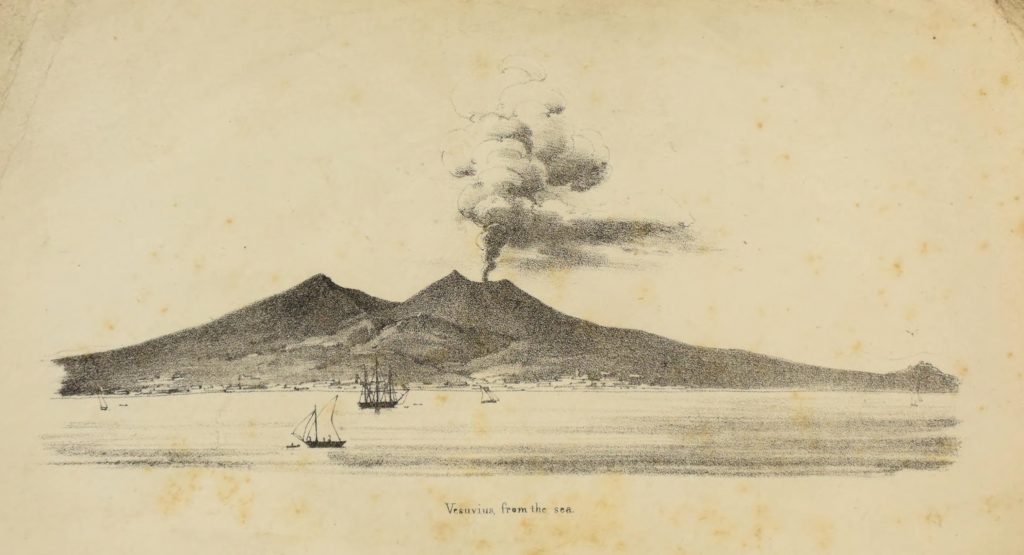
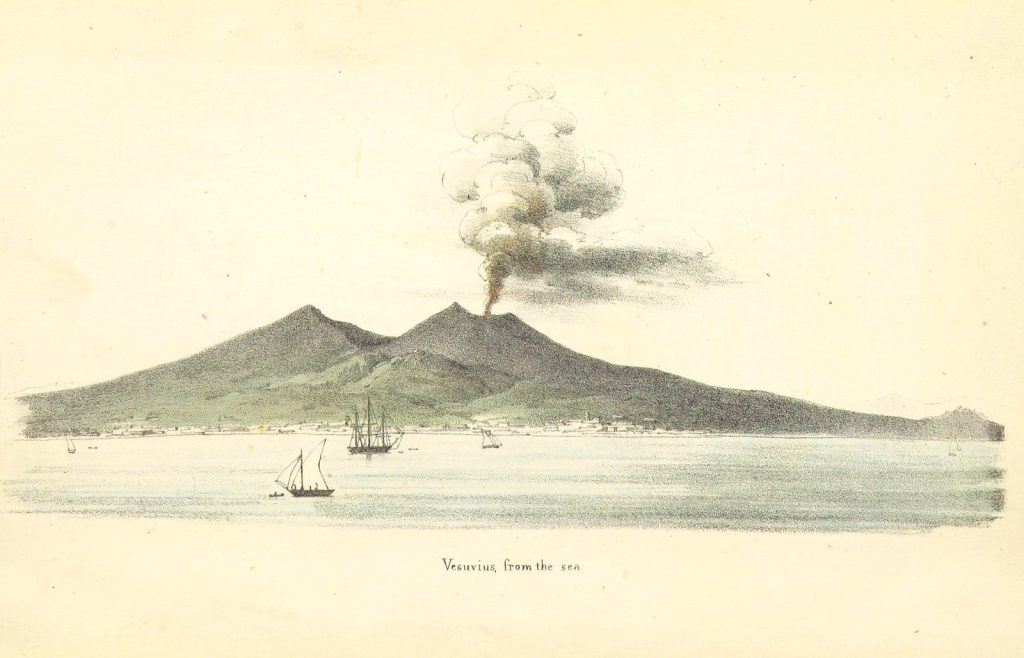
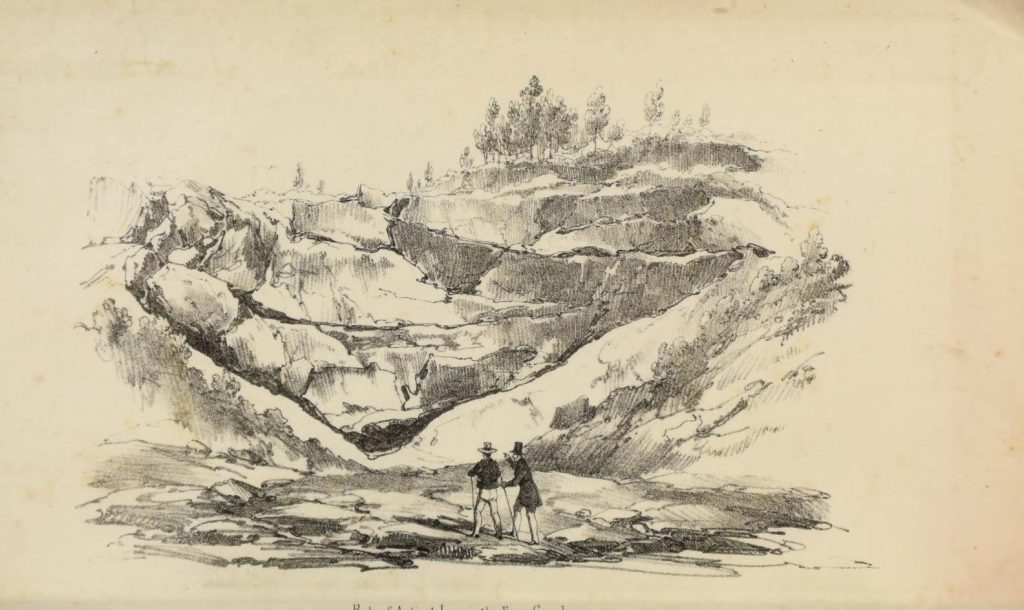
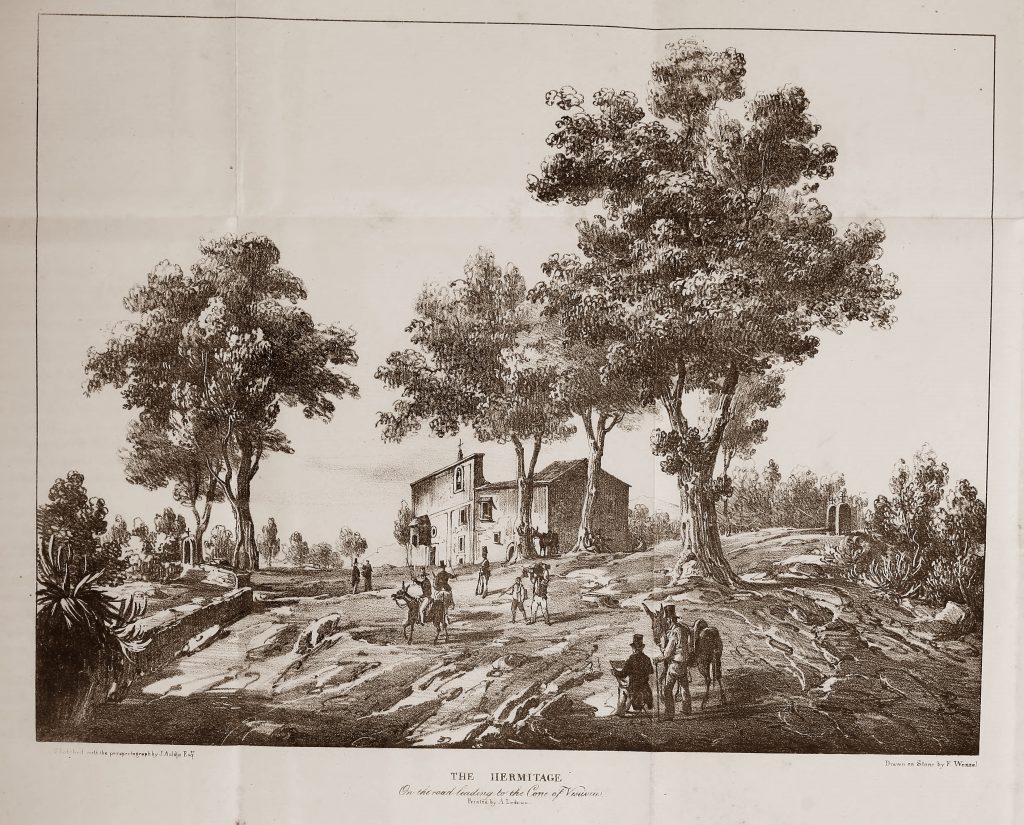
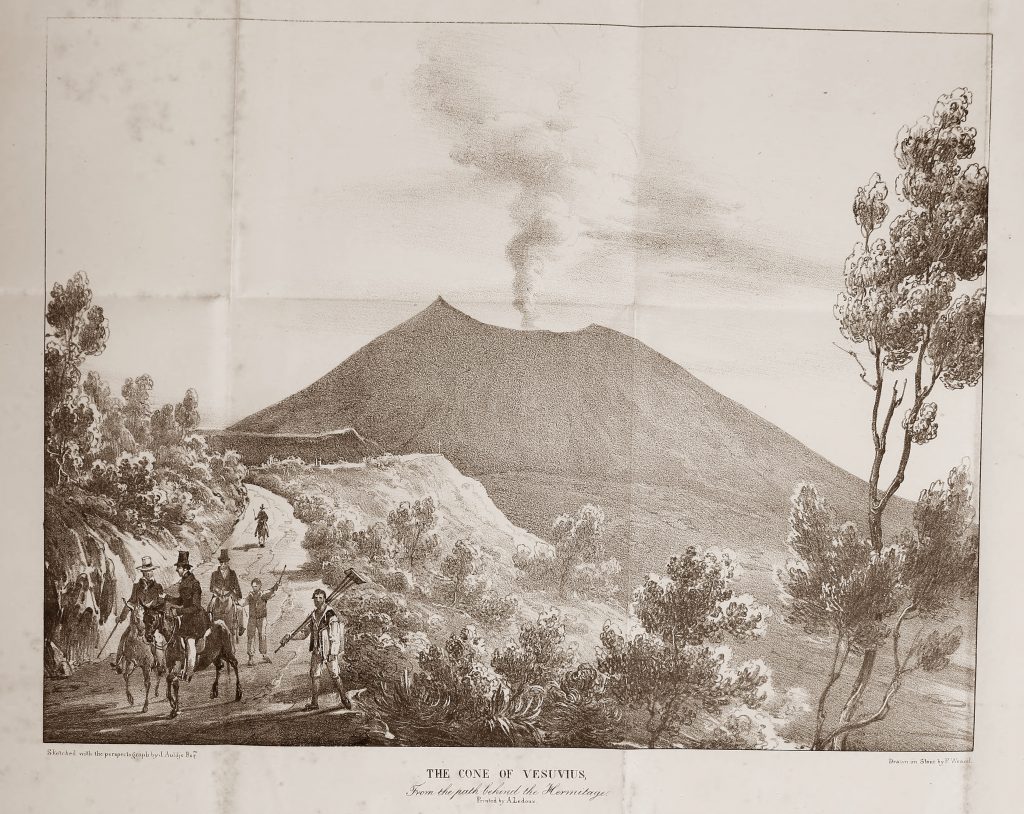


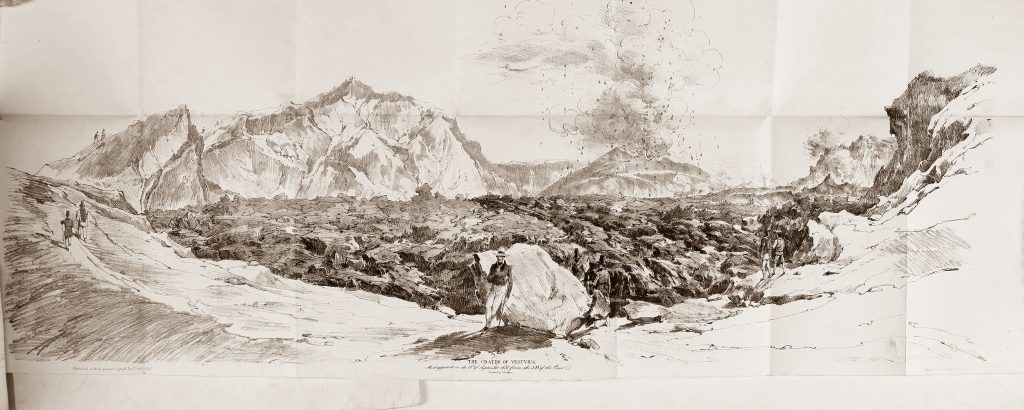
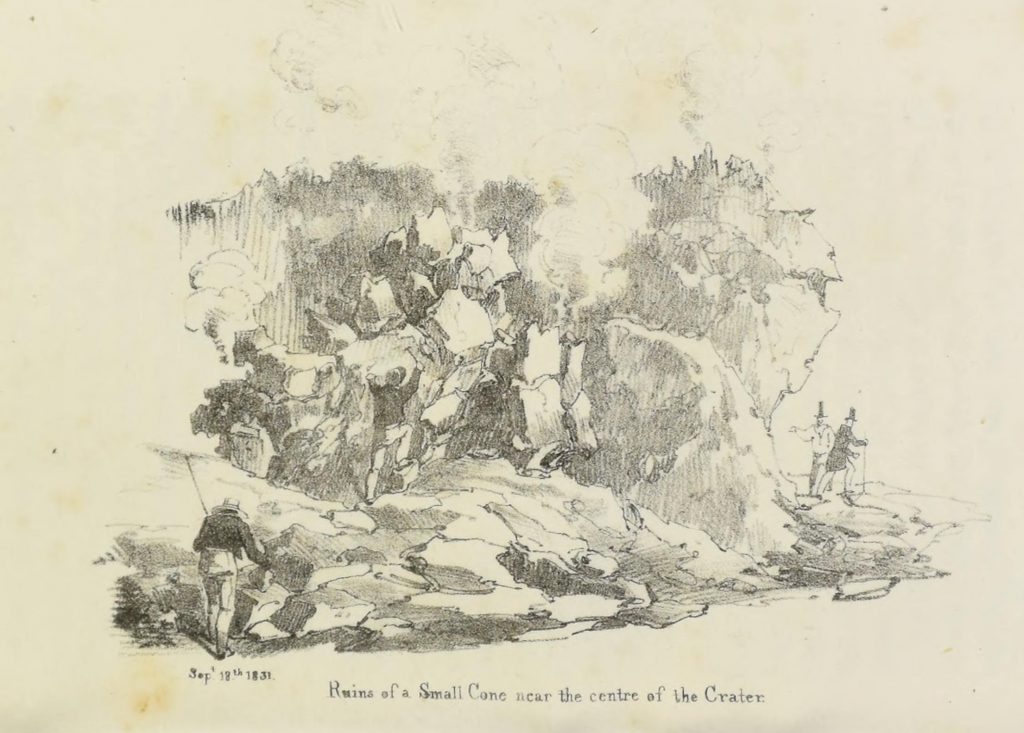
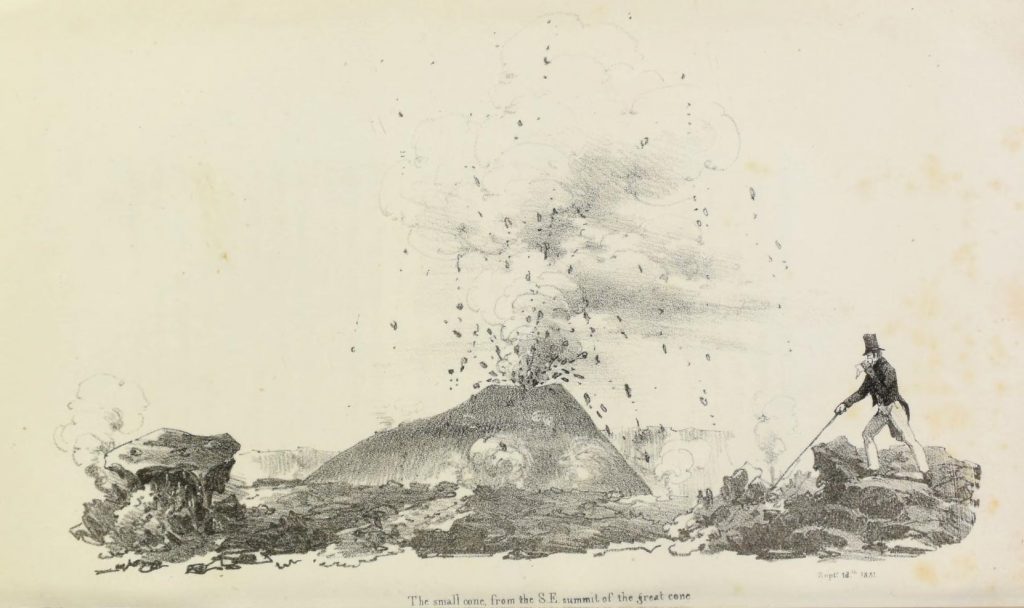
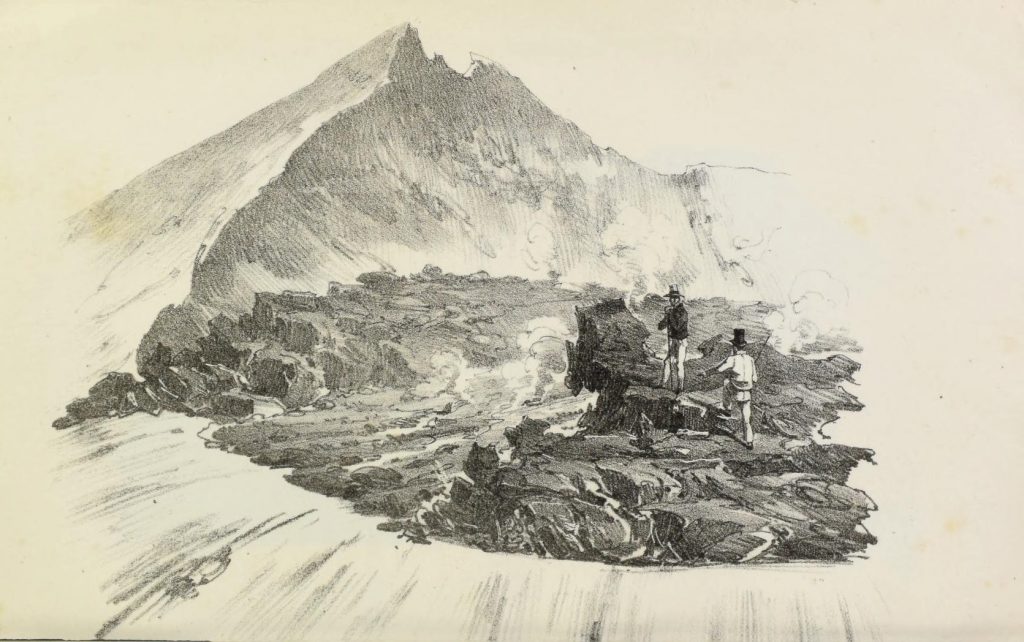
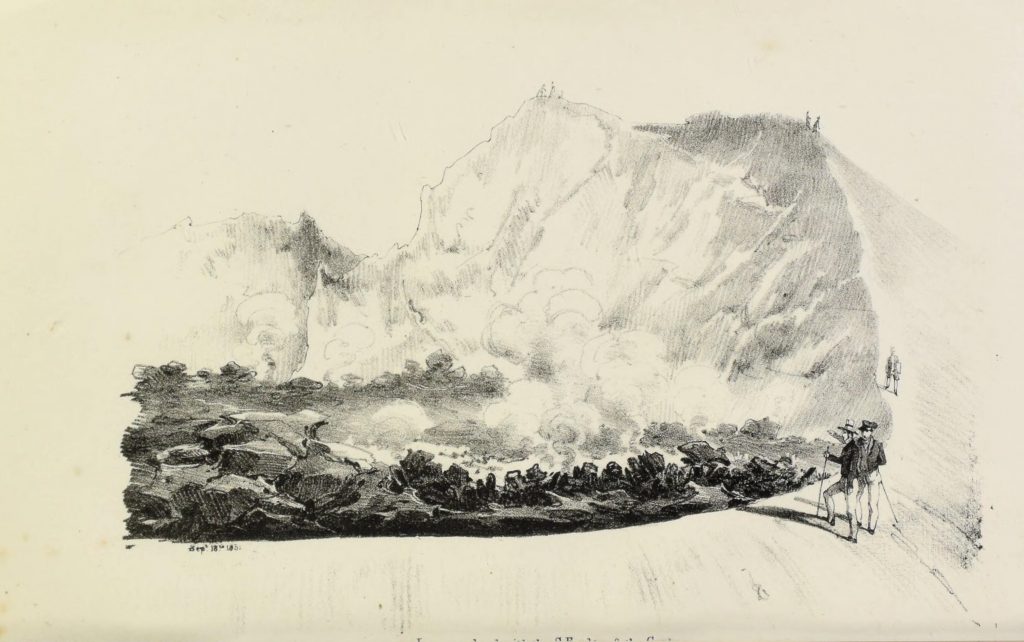
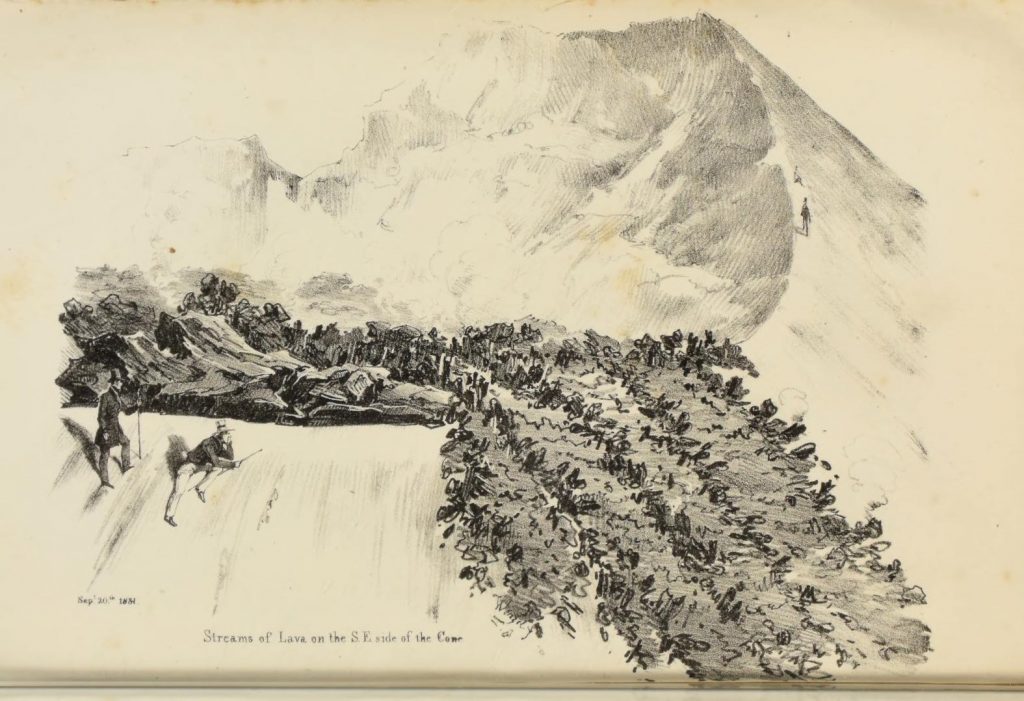

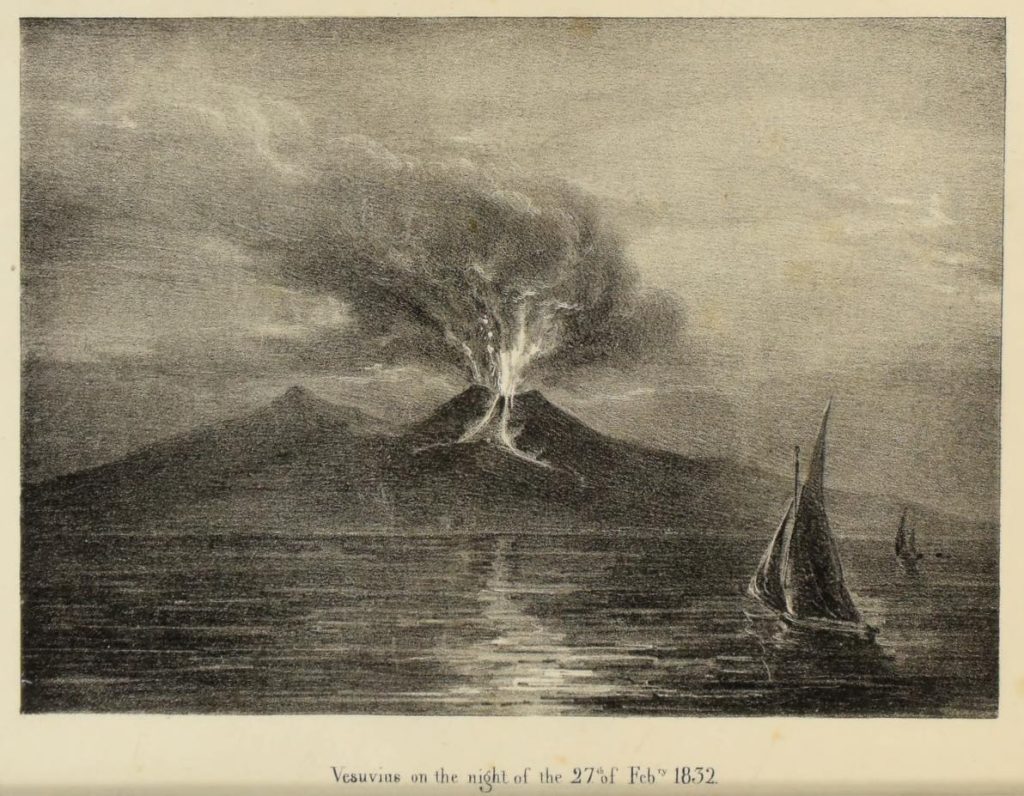
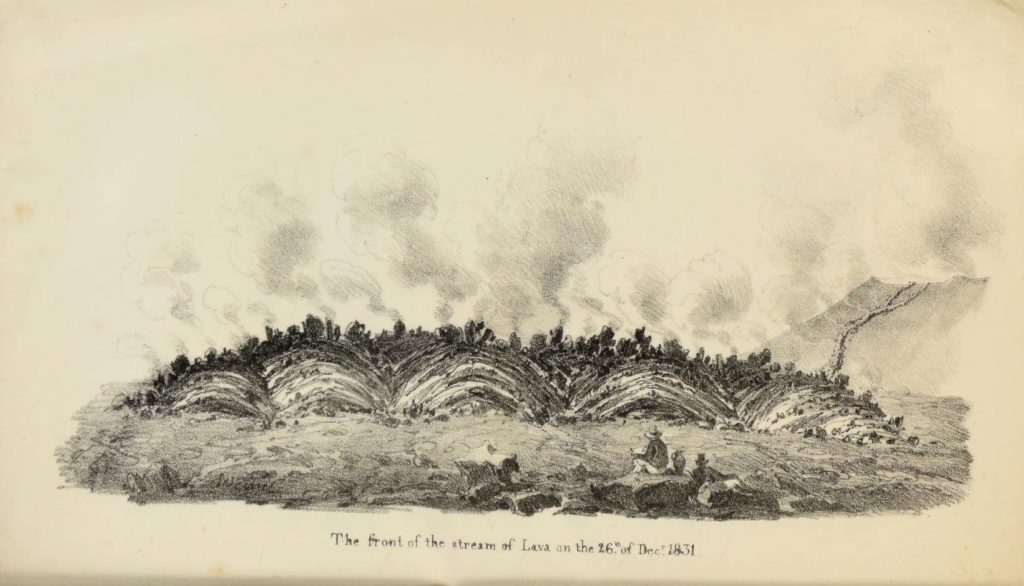
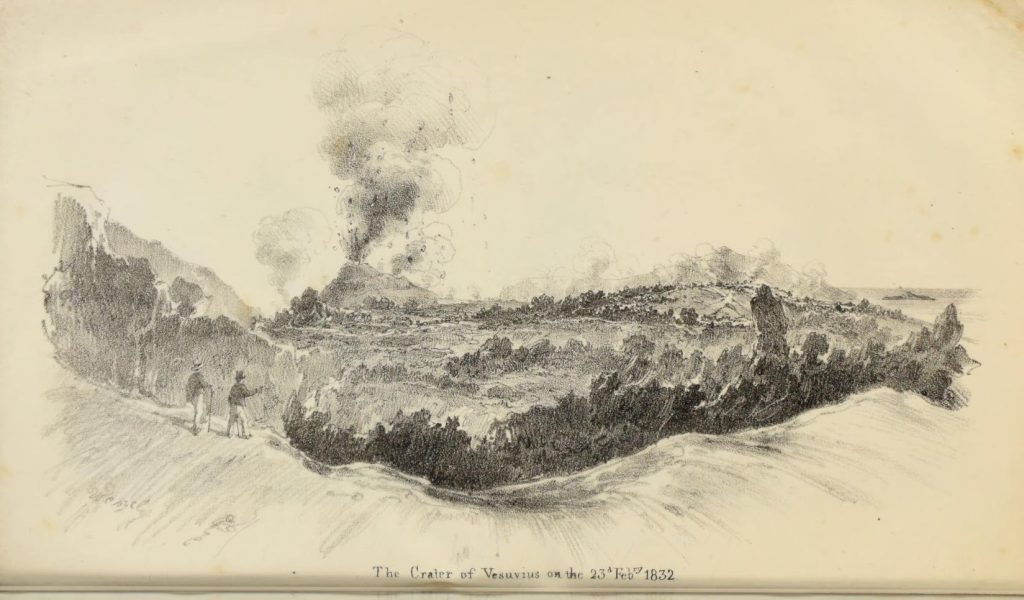
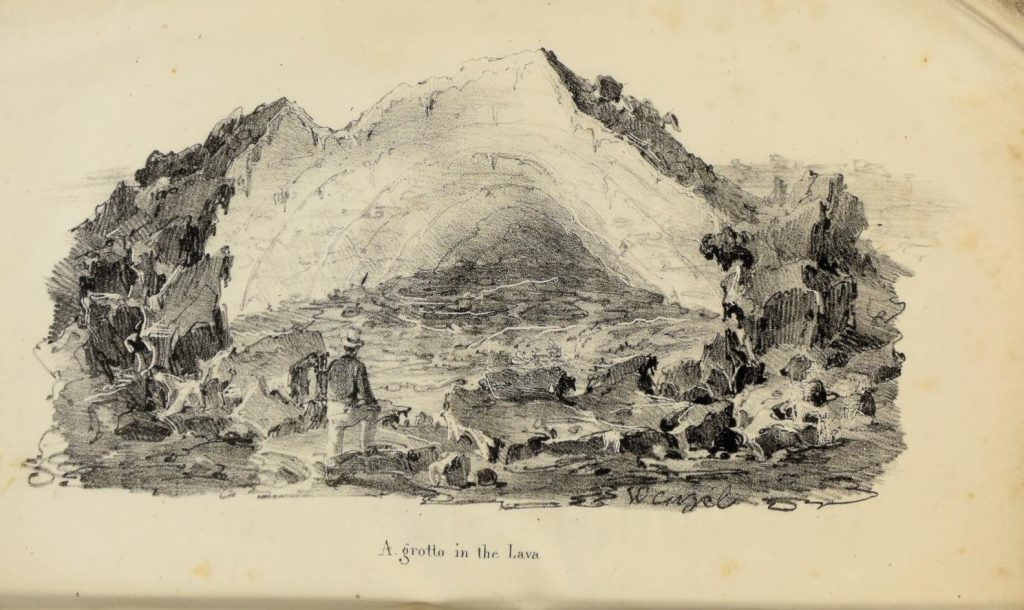
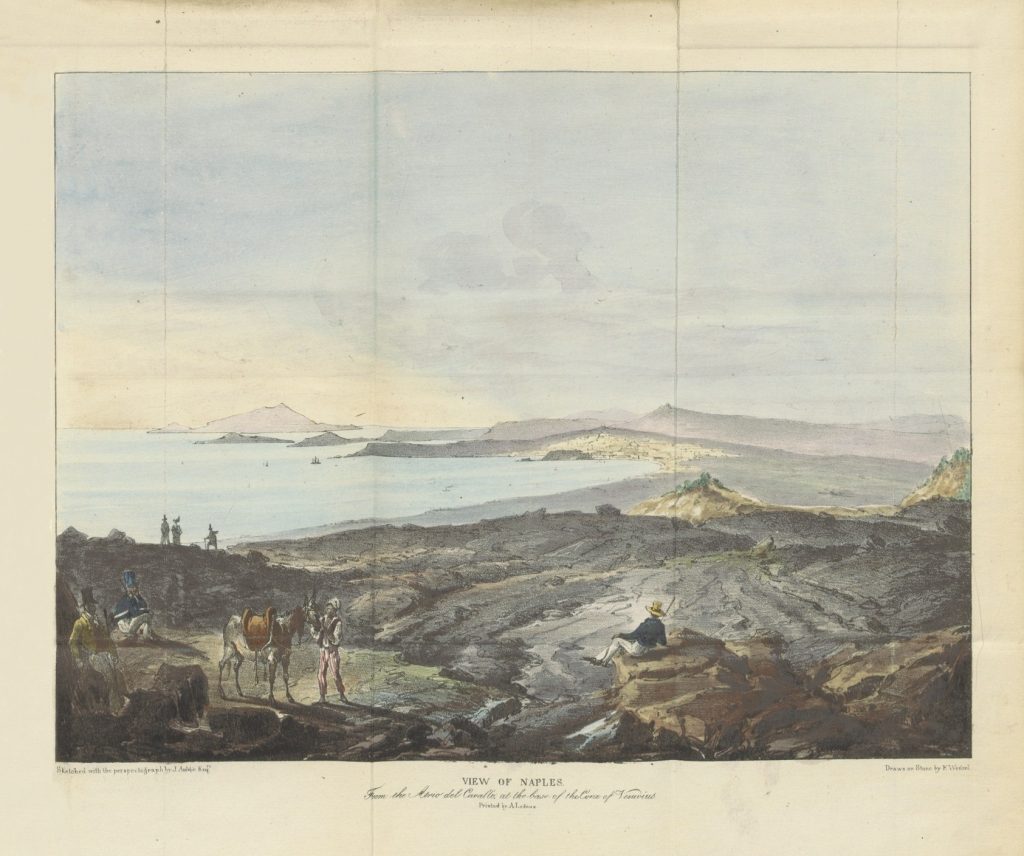
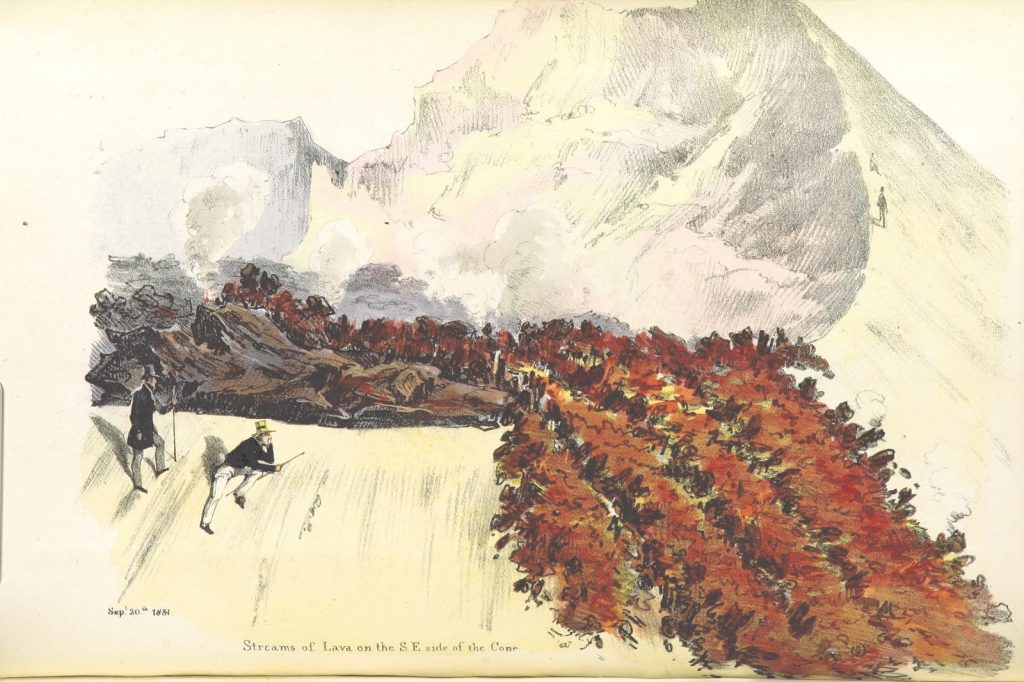
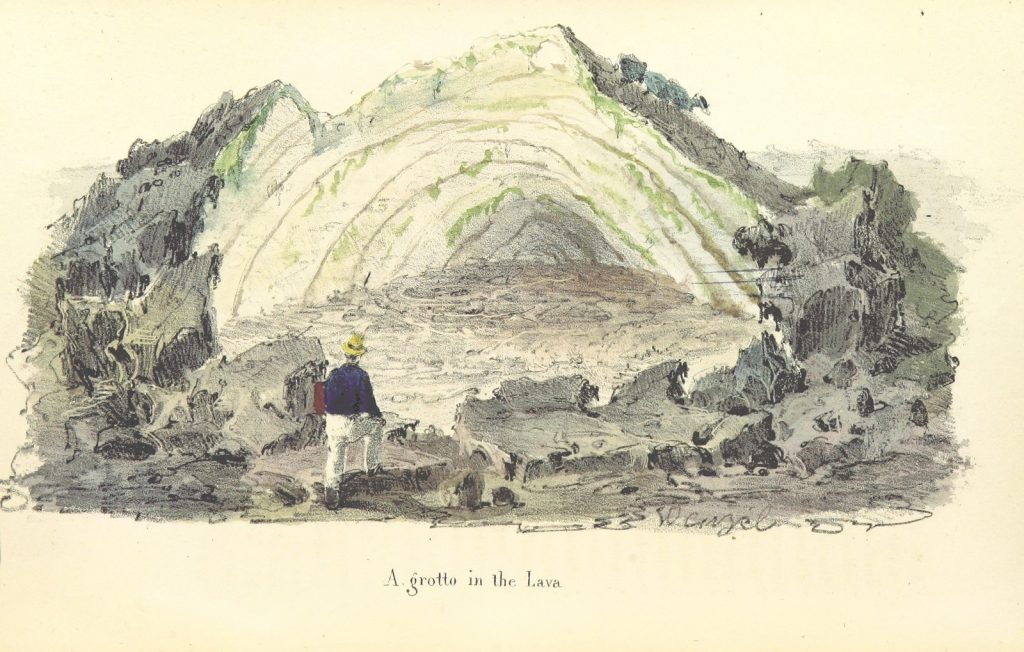
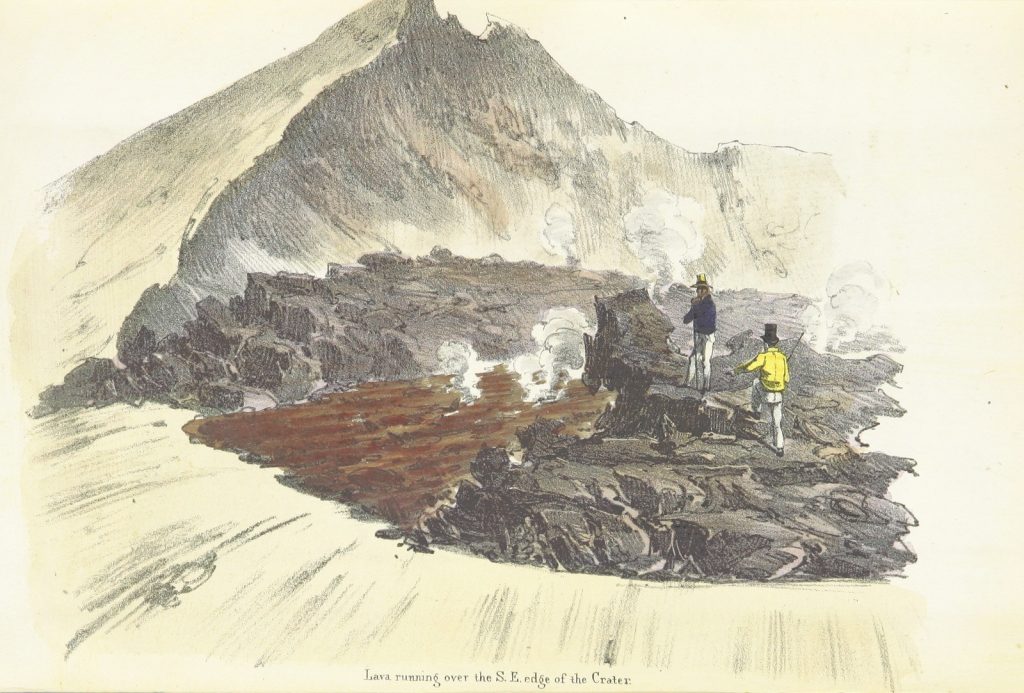
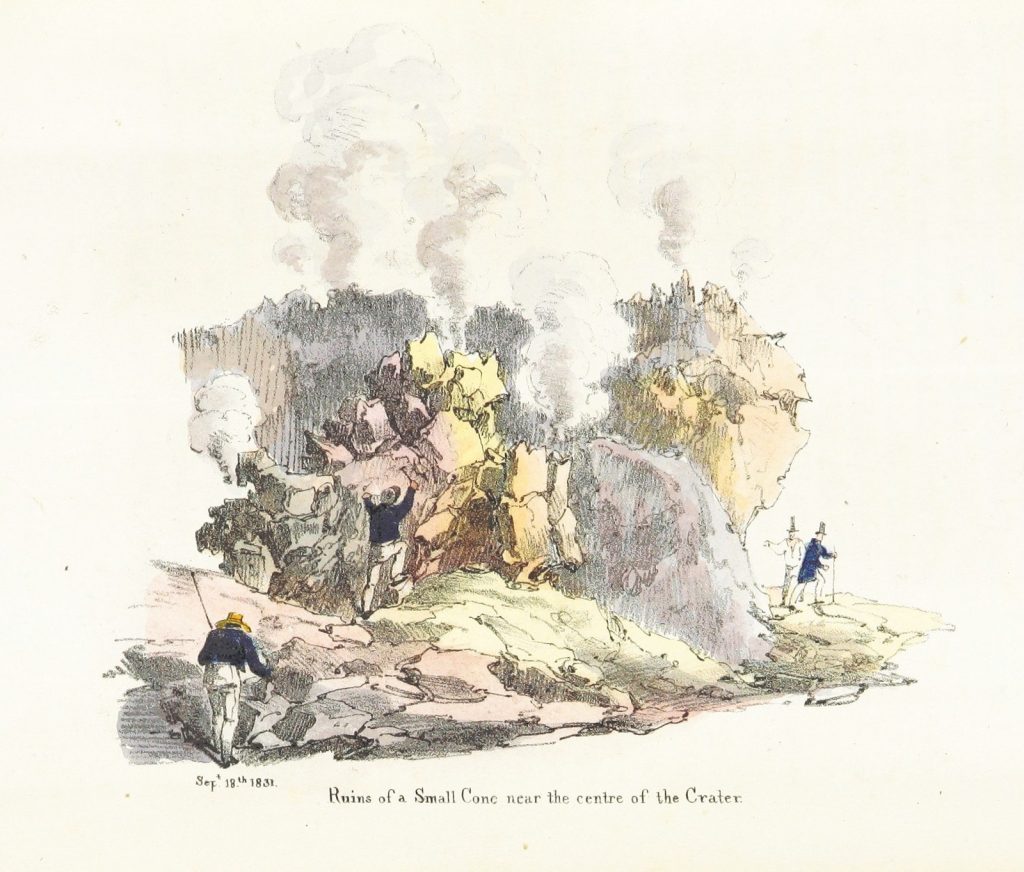
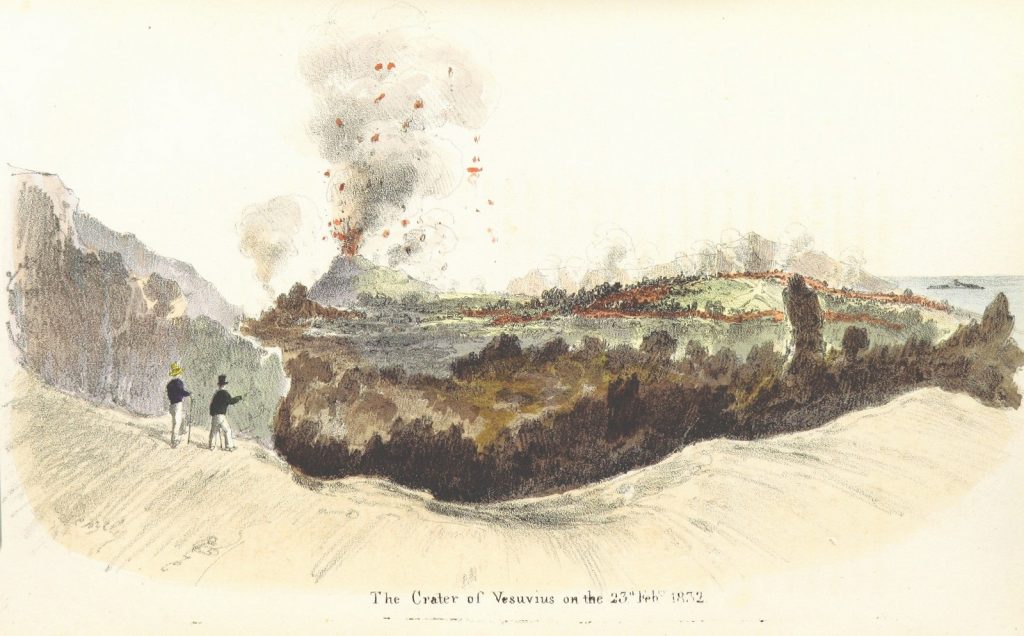
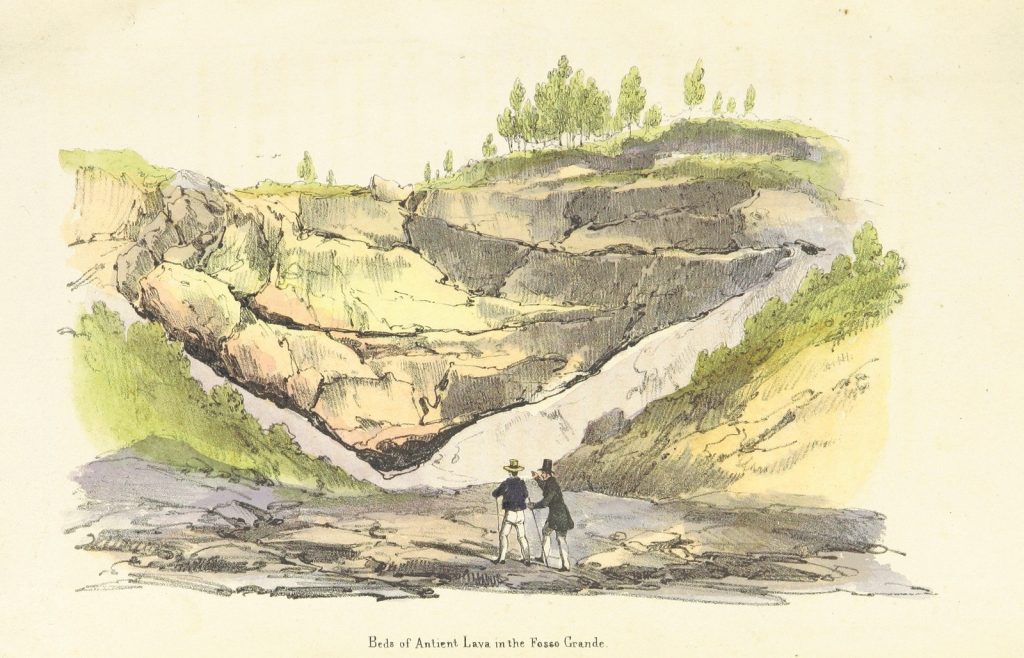
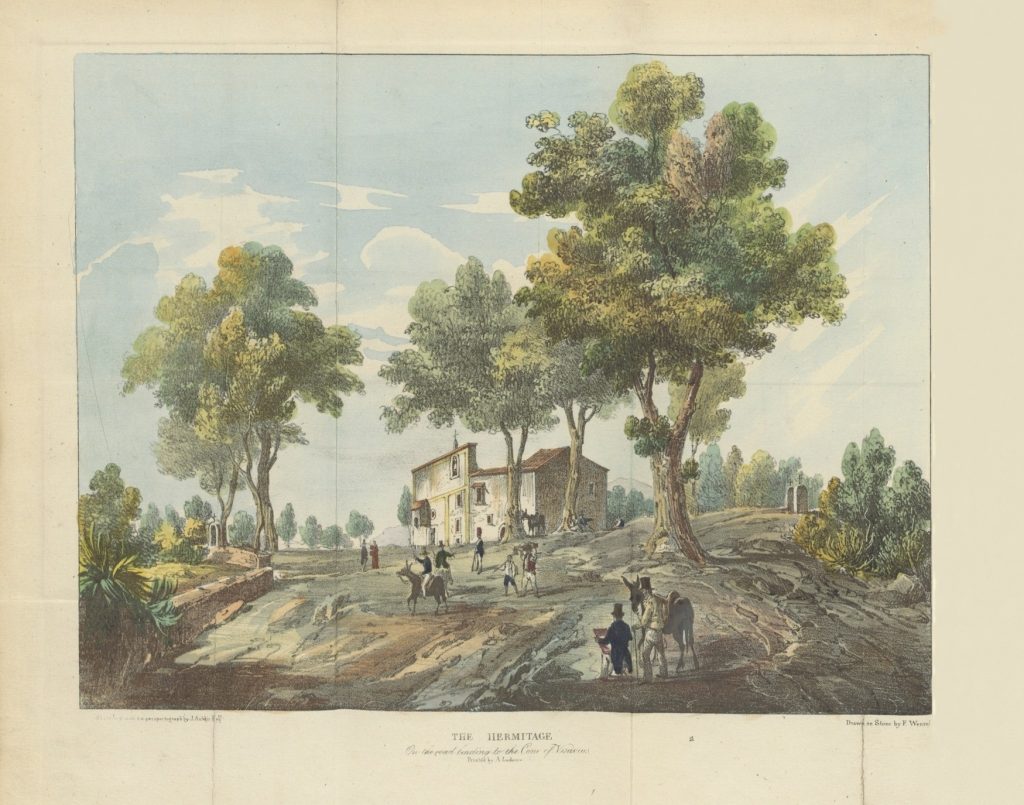
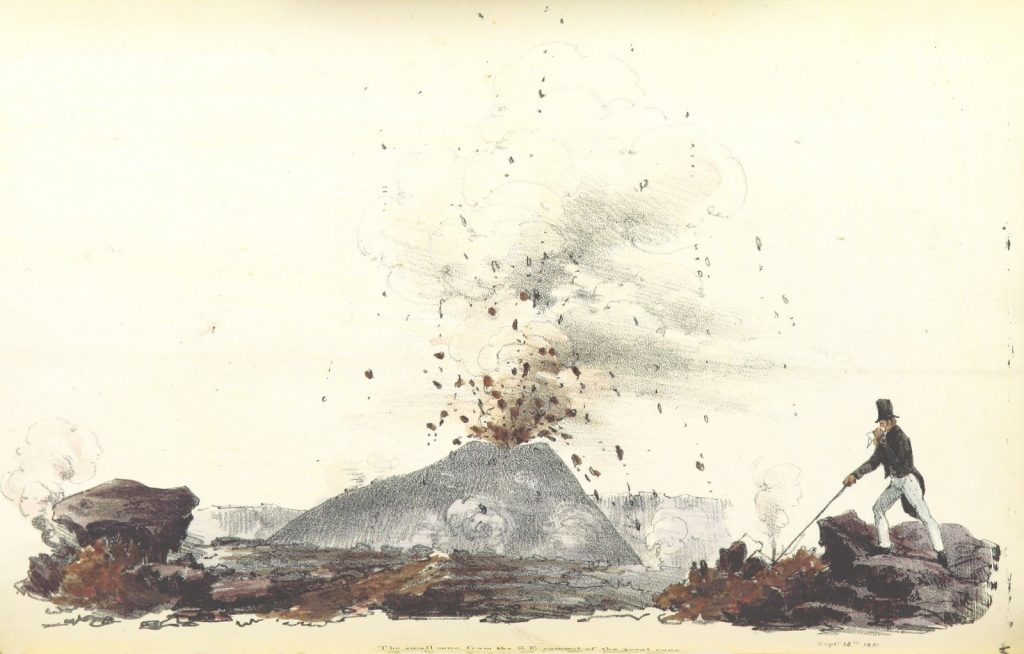

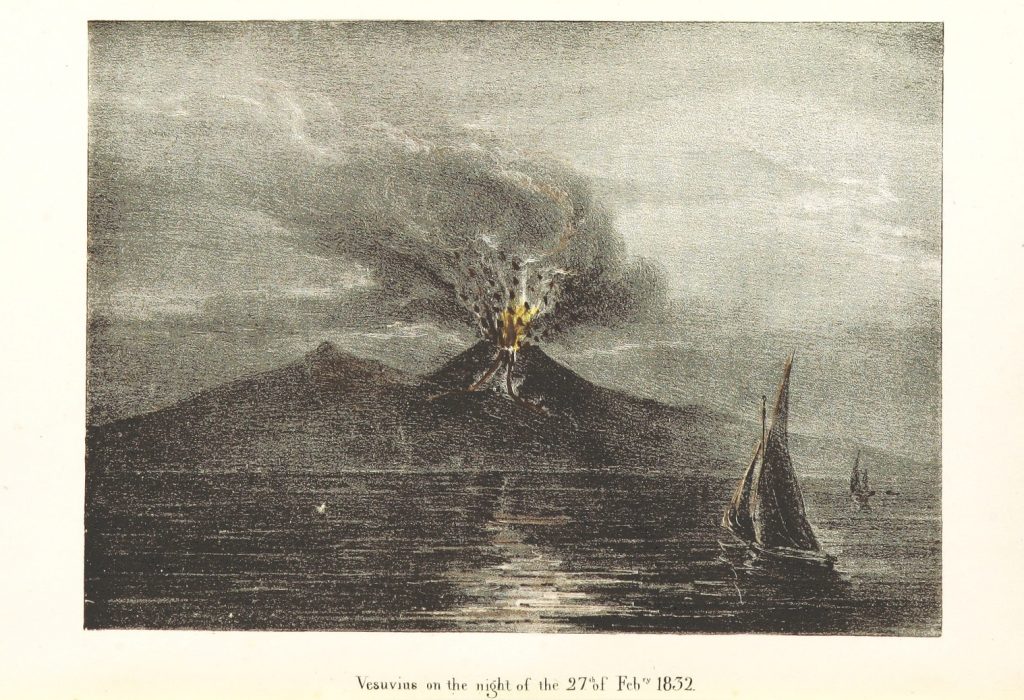
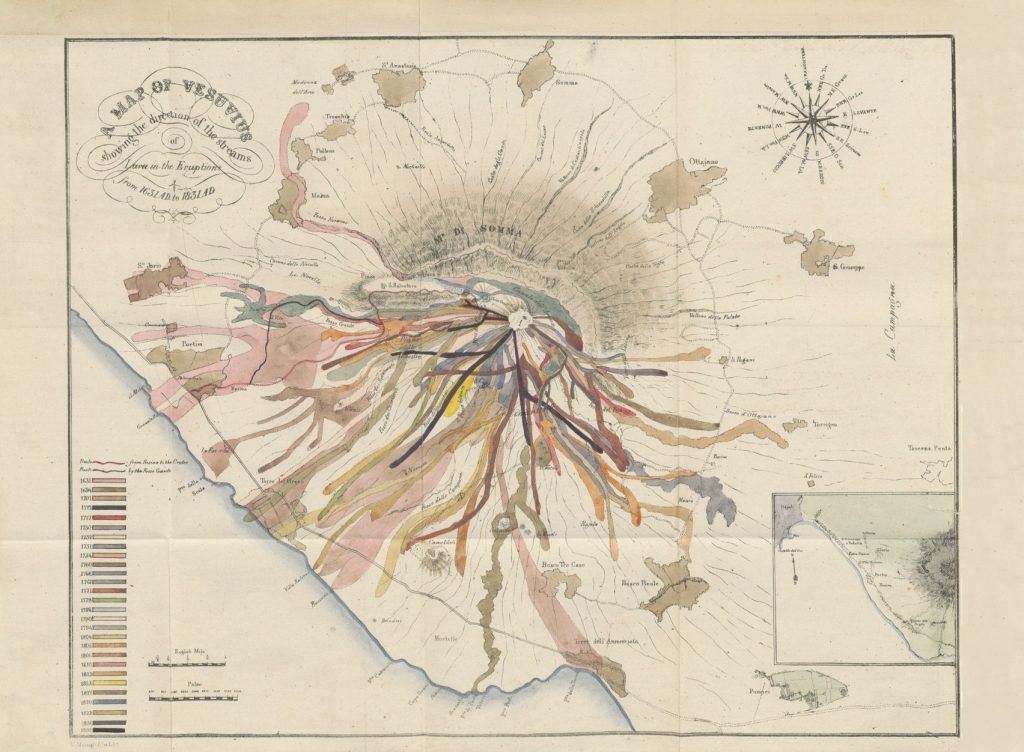
Splendido panorama delle immagini del Vesuvio e dettagli di lava ed eruzioni. Probabilmente disegni, acquerelli e forse incisioni. Molto stimolante per me … Sono stato affascinato da descrizioni molto belle, a volte poetiche. Un libro bello e molto prezioso per una conoscenza più approfondita del Vesuvio in epoche precedenti.
Grazie e salute
Jana